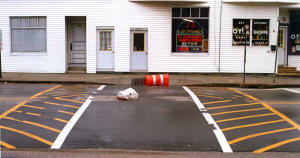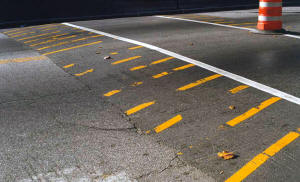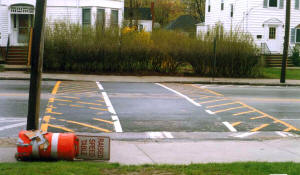Public Concern
Stevens Avenue Project: Public Concern
Right after the asphalt curbing got put in a home owner at the north end of Stevens arranged a meeting with DPW head William Bray and Tom Gorrill, one of the engineers at DeLuca-Hoffman Associates who designed the project. They were to meet in the parking lot of the Hayes Chiropractic Clinic at 808 Stevens Ave. on July 17th. Word of this got out, and Bill Bray arrived to find not just 2, but about 100 people VERY upset with what was going on. A couple of people liked the project but the great majority hated it.
This is a small part of the crowd at the meeting at 808 Stevens Ave. on July 17, 1997. Facing the crowd in the white shirt is William Bray, Director of DPW. Next to him in blue is Thomas Gorrill, of Deluca-Hoffman, Inc; Police Chief Michael Chitwood (hand to mouth); Mary Butler, DPW Public Affairs person; and Peter Hedrick (striped shirt), of DeLuca-Hoffman, Inc.
After an hour or so of somewhat heated and pointed questioning by the
assembled public Bray stated that he would have a public meeting about the
whole project the next week.
That was held at Catherine McCauley HS, which is located further
south on Stevens . About 400 people showed up, and it was about 25-1 against the
project.
Bill Bray and most of the city council was there, along with Fire Chief Thomas, Police Chief Chitwood, some DPW people, and all of the news media.
The tirades against the mess went on
for hours. The upshot was that City Council would take a vote to remove the
whole project at a future council meeting. Councilor Peter Rickett started that
movement, with Councilors Cheryl Leeman and Jack Dawson following.
All the
Democrats, Charles Harlow, Karen Geraghty, John MacDonough, Nicholas Mavadones,
and Robert Chambers, went along with supporting the project (I found out later that
they all were friends of Paula Craighead, especially Harlow. He was on the school committee
for years with her. They were all members of the Portland Democratic Committee,
which Paula was head of for a number of years. Was there a trend?).
A city council meeting was held, the result being that the curbing would come off the road and the project would stop for more study. Charlie Harlow and the Public Safety Committee would have to come up with an alternate plan for the avenue.
Harlow stated at that time that "We are going to do what we think is right, based upon what the people want". What he didn't say was that it was based upon what Paula and the members of the DCNA wanted. The great majority of the public were against the plan, and they were ignored.
There were 30 people that supported the project; well connected.
About 526 people from the neighborhood signed petitions asking for the projects
cessation and removal, but those petitions were "lost" by the City
managers office. They're probably in Jimmy Hoffa's coat pocket by now.
Petition 1 Petition
2 Petition 3
Petition 4
Petition 5
PORTLAND CITY COUNCIL
The public safety committee at the time of the project’s start was comprised of Charles Harlow, Karen Geraghty, and Jack Dawson. They had an illegal meeting the day after the council meeting at a restaurant at Northgate Plaza to hash out what kind of plan to present to the Council. Dawson was holding out for complete removal of the humps. Geraghty was going along with Harlow in keeping the humps, adding 6 more, plus a raised speed table at the intersection of Pleasant and Stevens, along with more marked crosswalks, flashing signs to tell motorists to stop for pedestrians in crosswalks, and orange cans with "speed table " signs on them telling people to stop for pedestrians in the crosswalks.
The meeting was illegal because under Maine law there has to be 2-week public notice of any meeting, it has to be open to the public, and minutes have to be taken. None of that was done. Harlow was leaving town for a while, and had to keep the ball rolling. This situation actually made the local paper, which complained about being left out of the action.
The asphalt curbing, chicanes, and medians were removed just a month after their installation. Even the most rabid proponents of the project realized they had a public relations disaster on their hands, and thus supported the removal. Paula Craighead, head of the Stevens Avenue Advisory Committee (SAAC), the woman who started the whole fiasco, bailed on DPWs William Bray just two weeks into the installation process, leaving him twisting in the wind.
Another council meeting was held, and the "alternate" proposal was voted in. This was the same disastrous plan as originally conceived, minus the unpopular asphalt curbing. Once again the Democrats voted for the project, the Republicans against it.
TRAFFIC COUNTING AND DOCUMENTATION
Traffic surveys were done in April and May of 1998, again by Deluca-Hoffman. It was first done the last week in April, then again, on the same day as the last traffic count in 1997, May 8, so as to replicate the dates conditions. In all three cases the weather was the same: clear and dry.
I
had gone to the
Traffic Engineers office on the Thursday of the third week of April 1998 to see
if any testing or counts were going to be done. Nobody there knew anything about
that.
Tuesday of the following week DPW crews were out on Stevens
putting down counting tapes! Oops!
This first test was thrown out, as it was seen as not being "equal" to the original a year prior, as it was two weeks earlier in the year.
A much more extensive set of traffic counts were done around the humps the second time about a week or so later, with tapes set at specific distances before and after the humps to determine just how fast people were going while approaching and leaving the hump sites.
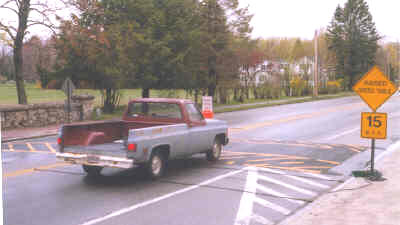 Truck
passing over the tapes and hump at Evergreen Cemetery, April 1998. Notice
the brake lights on as he slows for the hump. It's this braking and subsequent
acceleration that cause the massive pollution increase.
Truck
passing over the tapes and hump at Evergreen Cemetery, April 1998. Notice
the brake lights on as he slows for the hump. It's this braking and subsequent
acceleration that cause the massive pollution increase.
Notice
too the signs: yellow diamonds denote hazards! The white sign atop the orange
can in the middle of the road says "raised speed table". The
cans sign shape, color and
lettering were also incorrect for that application, according to FHWA Office of
Highway Safety.
This
is locally known as the "crosswalk to nowhere"
What they found was that cars slow upon approaching a hump, slowly move over it, then speed up to the next one where the process is repeated, generating LOTS of pollution.
Thomas Gorrill of Deluca-Hoffman, Inc. presented the findings of his testing to the City Council in September 1998. DHI found that about 2,500 cars a day were being diverted off Stevens Avenue, to just where, no-one knew (Forest Avenue being the likely location- already carrying 37,000 cars a day). He stated that the air quality on the avenue was being hurt because of the slowing and acceleration at the humps. He also said that there was a problem with delay of emergency vehicles at the humps.
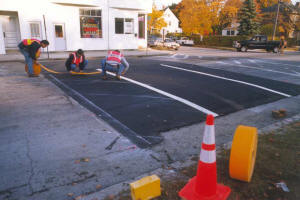 |
These humps were installed in November of 1997, marked with 3M Company marking tape made especially for the purpose.
Taping of the then new hump in front of Deering High School. The crew is laying out the marking tape, and pressing it down with a hot roller. It supposedly would bond with the pavement, becoming a permanent part of it. This worked somewhat. Over the winter and into the spring, chunks of it were ripped off by plows, peoples undercarriages, and trailers. In the Fall of 1998 before school started, paint was applied over the tape to clean up the markings, as it was again in 1999, 2000, and 2001. Paint is lots cheaper, and seems to last as long.
Traffic was moving between 3 and 15 miles an hour slower, again, with the greatest effect at the hump locations.
Accidents had gone up 58% in the five months since the hump installation.
Pedestrian and bicycle usage had dropped 8%.
Pedestrians did see a drop in waiting time to cross the street, from 6 seconds
to 1.5 seconds. (This figure might have been influenced by the counting of
teenagers at Deering HS just walking out into traffic as opposed to checking
first. This does not seem like a “good safety feature” to
a lot of people).
All in all, what with the increase
in accidents and traffic congestion, and decrease in air quality,
pedestrians, and bike usage, the project didn’t seem like too much of a good thing in
general.
With all of
this refutation of the original goals, you might think the move would be on to
remove the project as fast as possible........think again!
TRAFFIC CALMING POLICY IMPLEMENTATION
Because of the controversy concerning this project, the Portland DPW and City Council decided in the Spring of 1998 to formulate a traffic calming policy. The state DOT was going to use the city's policy as a model for its own policy, and together they would come to a method of applying traffic calming techniques to Maine streets. Experience gained from the Stevens Avenue project would be a prototype for the rest of the city and state. Various other cities, such as Portland, Oregon, were used as “models” for the Portland City Councils efforts.
It should be noted any information from the various city models that were allegedly contacted that contradicts the Stevens Avenue project or the contentions of Portland traffic calming supporters was and has been ignored. Portland City Council doesn't want to hear about it.
Early in 1998 I called the traffic calming offices in the cities Portland, Maine officials had contacted for information about traffic calming projects in their towns. Portland , Oregon was often mentioned by Portland officials as being very knowledgeable about the subject. They currently (March 2012) have over 1500 speed humps or tables on their streets, and another 50 or so roundabouts.
Ellis McCoy was the head of the Portland, OR traffic calming office at
the time . He
specifically told Portland DPW that they should not be calming Stevens
as it is a major arterial.
John Clement of the
Malibu, Cal. TC office told me Portland was going to "have big problems"
as Stevens had too much traffic, and was an emergency vehicle access
route. John liked humps a lot.
Terry
Sanville and Wayne Peterson of the San Luis Opisbo, Cal. TC
office told me their project was a bomb- it had to be taken up after 8
months on the road. SLO was touted as a successful project by DPW.
Our DPW ignored all that information. Every single
calming office Portland contacted told them not to install
humps on Stevens.
I called Transportation Research Labs in England, the people who invented speed tables back in the 1970s - they said Stevens should not be calmed- it was too much of an arterial for calming, too important a a road.
As "Victoria, Australian studies" were being bandied about, I called the
Victoria Australia Traffic Engineering office. Andrew O'Brien of Unit 3
told me that Stevens should not be speed humped, as not appropriate.
Various meetings were held by the City Council and Public Safety Committee throughout
1998 and into 1999 to fine tune the policy for implementation and the ordinance
controlling citizen application for
implementation. The city's traffic calming implementation policy(Chapter
28-250)_ was
voted into being in March of 1999.
Councilor
James Cloutier at the time, just before the vote, presented an amendment to
the ordinance that specifically withdrew the Stevens Project from the purview of
the ordinance, thereby making it immune from any attempt by the public to
remove it! There is a methodology in the
ordinance to remove an unwanted project, but after that aamendment the only body that
could call for
the removal of the Stevens Project was the City Council, by majority vote.
So much for democracy. Later, the Ordinance was rewritten so that the head
of DPW could remove any calming measures that were deemed to be dangerous, but
that method has never been used.
Councilor Cloutier said that it should be left on the road so that the
effects of the project can be studied over the next 2-3 years.
He didn't bother to tell anybody that there were no studies underway, and that
none were planned. There was no money in the
city budget for studies. The statement was nothing more than a smokescreen to mollify the
public to make them think that the Council was doing something positive and that
the project would be coming off the road.
What they were doing is endangering the lives and health of the Portland public, which continues to this day.
Because of the city’s touting the alleged “success” of the Stevens Avenue project, and general public unawareness of the problems concerning it, various neighborhood groups started petitioning the city for traffic calming on their streets, most of which were some of the major arterials of the city.
The city finally realized that some traffic calming considerations are not applicable to all streets. In the Winter of 1998-99 the city asked the state to formulate a state traffic calming policy so the city's calming policy would reflect the state's. The state in turn asked the Federal Highway Administration for guidance with its policy. The state policy was supposed to have been done by the end of January 1999 to accommodate the Portland City Council effort, but was delayed by waiting for comments from MDOT until August 1999.
In Nov. 1999 it was shelved by the MDOT Planning Division because they had more pressing things to take care of. According to Michael Danforth of the Planning Division, if there is a need for it in the future it will be dusted off and looked at anew.
As the "new" Traffic Ordinance made it a lot harder for politicians to
mollify their constituents, in that they just couldn't slap calming down
on the road like they wanted to, the pols developed the technique of
just ignoring their own law, and started ordering DPW to do what they
were told!
Hence,
illegal stop signs started popping up all over town and DPW morale
crashed.
All of this mess is explained in detail in the Portland Council of
Governments 2005 Traffic Calming review.
Next to : Air Quality

